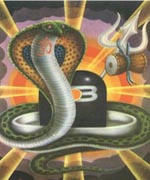|
Festivals of India
Nagapanchami
|
|||||
Nagapanchami is a festival dedicated to the snake-god. It occurs on the fifth day (panchami) of the fortnight as is evident from it's name. This festival is observed sometime in July/August. In 2016 it is on 7th August, and in 2017 it is on 27th July. It is celebrated with great fervour especially in the rural areas. On that day women and children visit snake-pits and worship the snakes residing there by performing Aarti (invocative prayer) and offering milk and honey to the snakes. |
Festivals Of India • Festival Calendar • Ganesh Chaturthi • Ramanavami • Janmastami • Diwali • MahaShivratri
• Passage to India | ||||
 On Nagapanchami, Hindus worship the Naag (cobra).Worshipping a slithering reptile whose mere sight makes our flesh creep would appear strange and curious to a person from another part of the globe, unfamiliar with Hindu customs. Snakes have been associated with many Hindu gods. Sheshnaga (Snake with Six hoods) is the vehicle of Vishnu. The world according to Hindu mythology and cosmogony, rests on the head of Sheshnaga, and when he shakes his head we have earthquakes (This explanation, of course is for the devout).
On Nagapanchami, Hindus worship the Naag (cobra).Worshipping a slithering reptile whose mere sight makes our flesh creep would appear strange and curious to a person from another part of the globe, unfamiliar with Hindu customs. Snakes have been associated with many Hindu gods. Sheshnaga (Snake with Six hoods) is the vehicle of Vishnu. The world according to Hindu mythology and cosmogony, rests on the head of Sheshnaga, and when he shakes his head we have earthquakes (This explanation, of course is for the devout).
ln another episode Krishna is said to have battled with Kalia who is portrayed as a giant snake with multiple hoods, who resided in the Yamuna river and terrorised people living nearby. But strangely, worship of the snake Naga on Nagapanchami day is not associated with any of these deified snake-gods. Naga is a deity in his own right and is worshipped as such. This indicates that apart from all mythologies which have eulogized and deified this reptile, his worship during Nagapanchami owes its origin to some other source.
Agricultural Origins of Nagpanchami In countries like India the reaping of the harvest is (still largely) a manual operation for the performance of which farmers have to mote among the dense crops for cutting them before the threshing, dehusking, etc. In doing so, the farmers expose themselves to the danger of snakebite from reptiles lurking unseen among the dense crop. From this fear and for providing psychological comfort for themselves farmers propitiate worship of the snake god.
|
|||||
|
|
|||||
Editor: Romola Butalia (c) India Travelogue. All rights reserved. |
|||||
